Matter over Mind: The crash of Turkish Airlines flight 6491
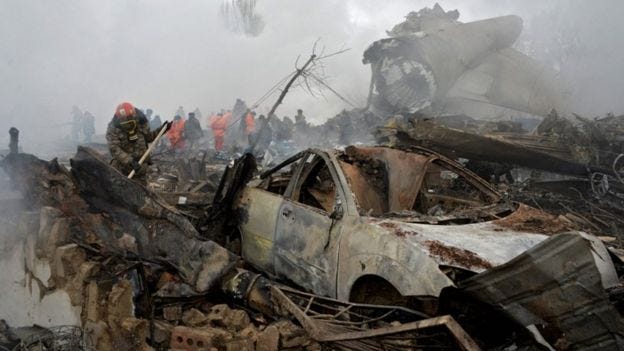
On the 16th of January 2017, a Turkish cargo plane was coming in to land in Bishkek, Kyrgyzstan amid heavy fog when it overshot the airport. The Boeing 747 touched down well past the end of the runway and plowed into a village, flattening more than two dozen buildings and killing 39 people, including all four people on board the plane and 35 more on the ground. As rescuers combed through the rubble in search of survivors, investigators from the Interstate Aviation Committee set about finding the cause of the crash. The details of the flight were troubling: the 747 was too high throughout its approach, and the pilots knew it, but they never took the necessary measures to lose altitude. Instead, the captain seemed to be agitated and angry, blaming the controller for the excessive height in a burst of foul language. In this highly tense environment, a misleading indication suggested that they were on course for 17 critical seconds, convincing the pilots to continue in the face of mounting evidence that their approach was dangerously misaligned. In fact, amid the heavy workload, bad weather, and flaring tempers, it was confirmation bias that sealed the fate of Turkish Airlines flight 6491.
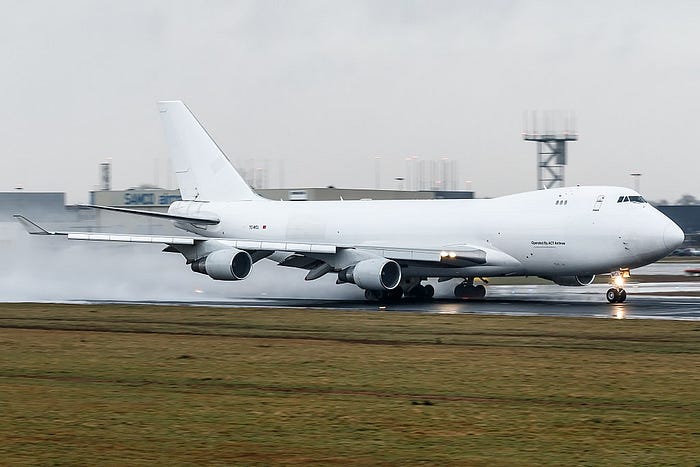
The story of one of Central Asia’s most terrifying air disasters begins with a small Turkish cargo carrier called ACT Airlines. Formerly known as MyCargo, the Istanbul-based carrier was founded in 2004 and uses a fleet of wide body jets to carry consumer goods around the world. Like many cargo airlines, it typically operates on behalf of other carriers’ cargo divisions, particularly Turkish Airlines and Saudia, and its planes were sometimes painted in these airlines’ livery. Among ACT’s fleet in 2017 was a Boeing 747–400F with the registration TC-MCL. Built in 2003 as a dedicated cargo aircraft, the 747 freighter had been painted plain white with only a single inconspicuous marking to denote the operator.

Early in the morning on the 16th of January 2017, TC-MCL was scheduled to fly a load of consumer products from Hong Kong to Istanbul with a refueling and crew change stop in Bishkek, capital of the Central Asian Republic of Kyrgyzstan. Although the flight was operated by ACT Airlines, it was performed on behalf of Turkish Airlines’ cargo division and used a Turkish Airlines callsign. The crew consisted of four people: Captain Ibrahim Dirancı, First Officer Kazım Öndül, loadmaster Ihsan Koca, and cargo handler Melih Aslan.
The two Turkish pilots were both 59 years old, and both had thousands of flying hours with no major training issues or previous incidents. However, they might have been suffering from fatigue, given the time of day. After a delay at the gate lasting more than two hours, flight 6491 to Bishkek and Istanbul finally departed Hong Kong at 3:12 a.m. local time, by which point the pilots had already been on duty for five hours and could expect to be in the air for six more.
Weather conditions at Manas International Airport outside Bishkek that morning were awful, with reports of freezing fog and low visibility at ground level. However, the 747 operating the flight (like many other modern aircraft) was fitted with autoland technology, which in combination with Captain Dirancı’s certification would allow them to legally land at Manas with visibility as low 300 meters.
As flight 6491 neared Bishkek in cruise flight, the crew performed the approach briefing. An approach into Manas Airport from the southeast would begin at a waypoint called RAXAT, which featured a minimum safe altitude of 17,165 feet in order to keep planes away from the high peaks of the Tien Shan Mountains. After that, they would fly to another waypoint called TOKPA, located 50km northwest of RAXAT, where they needed to be at (but not lower than) 6,000 feet. Following this, they would execute a left turn to line up with the runway, then level off at 3,400 feet to capture the glide slope. Manas Airport was equipped with an Instrument Landing System, or ILS, which could guide aircraft to the runway by emitting a “glide slope” signal. By following the glide slope signal, an incoming aircraft can descend at a 3-degree angle straight to the touchdown zone on the runway. After intercepting the beam of the glide slope at 3,400 feet, the only remaining step was to follow it down and land. Dirancı noted during his briefing that if they deviated from the ILS signal below 1,000 feet, they would immediately abandon the approach and go around.

At 6:51, the Bishkek area controller cleared flight 6491 to descend to 22,000 feet and reported that visibility over the runway threshold was 400 meters. “Good, look, now it is within limits,” Dirancı said, pleased with the news that the landing could go ahead. That meant they needed to lose altitude fast.
At 6:59, still at 22,000 feet, Dirancı instructed the First Officer Öndül to request a further descent. However, the controller denied their request, instructing them to remain at 22,000 feet until they received further instructions.
“Don’t leave us high, you [expletive],” said Dirancı, expressing his frustration with the denial of clearance.
“I guess he is going to give it after passing over the mountains,” Öndül said, correctly guessing the controller’s reason for keeping them high.
At 7:03, Dirancı again said, “We are starting to be high,” and he repeatedly ordered Öndül to request further descent clearance.
Finally, the controller replied, “Turkish 6491, you are 32 kilometers inbound [to] point RAXAT. To point RAXAT descend flight level one eight zero, not lower.” Due to the mountains, the minimum safe altitude at RAXAT was more than 17,000 feet, so 18,000 feet was as low as the controller could clear them.
As the flight neared the RAXAT waypoint, they leveled off at 18,000 feet and the area controller handed them over to the approach controller. Although they had not yet passed the waypoint, Dirancı told Öndül to “ask for a descent right away.” In response, the controller cleared them to descend to 6,000 feet by the TOKPA waypoint, in accordance with the published approach pattern. However, they had only 50 kilometers to lose 12,000 feet of altitude, which would require a steep descent, and this did not sit well with Captain Dirancı. “They left us high again,” he complained.
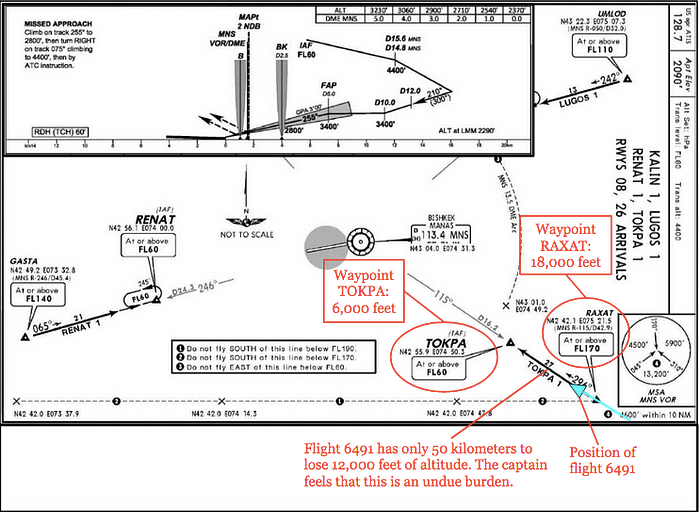
At 7:06, flight 6491 passed over RAXAT and began its descent toward 6,000 feet. To lose so much altitude over such a short period, the 747 (and every other airplane flying this approach) needed to descend at about 1.3 times the standard rate, which would require the use of the speed brakes. The speed brakes are spoilers on the wings which pop up and interrupt airflow, reducing lift and increasing the plane’s rate of descent. Simply reducing thrust to idle and pitching down would be insufficient. But despite his concern that they were too high, Dirancı did not deploy the speed brakes, for reasons that are difficult to fathom. Within a very short period of time it should have been obvious that without this extra measure, they wouldn’t reach 6,000 feet by the time they passed TOKPA. Eventually Dirancı must have realized that more drastic measures were needed, because he finally deployed the speed brakes at an altitude of 12,200 feet, much too late to make up the difference. Two minutes later, flight 6491 passed over TOKPA at an altitude of 9,200 feet, more than 3,000 feet higher than recommended.
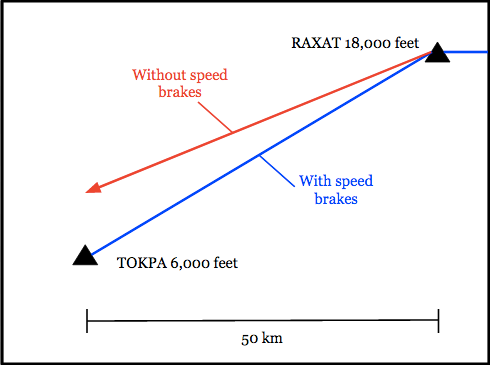
By this point there was not a lot of time left to lose an extra 3,000 feet; realistically, the only way to do so would have been to enter a holding pattern to bleed off the excess altitude. But the crew of flight 6491 never did this. Instead, they pressed onward toward the airport, passing over the next waypoint 2,100 feet too high. Moments later, First Officer Öndül commented, “We may end up high, and we have speed as well.” But Captain Dirancı never replied, and no one suggested a course of action that would solve the problem, as though they believed it would go away by itself.
The next problem facing the crew was the glide slope interception. The approach plan called for them to level off at 3,400 feet at a point 11.5 kilometers from the runway, then maintain this height until the 7.4-kilometer point, also known as the final approach point (FAP), where they would intercept the glide slope from below. However, flight 6491 passed over the 11.5-kilometer point at a height of 5,300 feet instead of 3,400. After passing this point, Dirancı ordered Öndül to look for the runway — again, a violation of standard procedures, which called for the non-flying pilot to continuously monitor the instruments when conducting an approach in low visibility.

Moments later, flight 6491 overflew the FAP at a height of 4,000 feet, too high for the instruments to pick up the signal from the glide slope. But neither pilot seemed to realize this. Instead, Dirancı became increasingly agitated about their excessive altitude. “Fuck, he left us high, fucking faggot!” he exclaimed, venting his anger at the air traffic controller.
Unnerved by the outburst, Öndül sought to calm him down. “Come on, nothing happened!” he pleaded.
At 7:15, at a distance of only 4.6 kilometers from the runway, the autopilot leveled off at 3,400 feet, as it had been programmed to do. However, they were already past the point at which they should have left this altitude, and it was much too late to intercept the glide slope. The only solution now was to go around and try again. But neither pilot seemed to understand how close they were to the runway. It certainly didn’t help that when they passed over the outer marker, a beacon located close to the airport, the accompanying audio annunciation never went off — because the crew had disabled it. Seconds later, the controller cleared the flight to land, unaware that it was impossible for the 747 to reach the runway from its current position. Although Manas Airport had radar, this controller wasn’t certified to use it, and radar data was not displayed on his screen. Responsibility for recognizing the problem would have to lie with the crew.

The last critical link in the chain of events occurred shortly before 7:16 a.m., when the glide slope receivers suddenly detected a signal from the instrument landing system. When a glide slope signal is emitted, the waves bounce off the ground and off the equipment and create ghostly reflections of the beam at progressively steeper angles. Known as false glide slopes, these erroneous signals can be found at intervals of three degrees above the real glide slope. A typical glide slope always extends upward at a three degree angle, but false glide slopes also exist at six degrees, nine degrees, twelve degrees, and so on. Normally planes never encounter these spurious signals because they can only be found well above the prescribed approach path. But as flight 6491 cruised at 3,400 feet while only 2 kilometers from the runway, it ran right into the false glide slope at nine degrees. Upon receiving the signal, the pilots’ glide slope indicators came to life and the autopilot automatically initiated a descent on a three degree angle, as it would upon intercepting the real glide slope. “Glide slope capture!” Dirancı called out, to which he immediately added that the autoland system had successfully engaged.

Unknown to the pilots, the glide slope receivers had actually lost the signal only two seconds after acquiring it, because a three-degree descent rapidly took the plane away from the nine-degree beam. However, the system was designed to wait 15 seconds before informing the crew about the loss of the signal, in order to prevent nuisance alarms due to ephemeral signal interruptions. As a result, all instruments suggested that the plane was established on the glide slope for a full 17 seconds. During this time, the autopilot kept the plane in a three-degree descent, a feature intended to ensure that the plane does not deviate from the glide slope in the event of an equipment failure.
Of course, the signal never returned. After the 15-second waiting period was over, the system informed the pilots of the loss of the glide slope signal by triggering a master caution alert, an autopilot caution message, and several other indications. Remarkably, neither pilot acknowledged the sudden cascade of alerts. According to Captain Dirancı’s own approach briefing, he intended to go around in the event that the ILS signal was lost, but in the event he failed to do so. The pilots had become so fixated on landing that it all went in one ear and out the other. As the crew searched frantically for the lights of the runway, the 747 continued to descend at a steady three-degree angle down into the swirling fog.

At a height of 500 feet above the ground, the Enhanced Ground Proximity Warning System (EGPWS) began to call out, “GLIDE SLOPE! GLIDE SLOPE!” This warning was supposed to trigger an immediate go-around, but once again, the crew did not react to their airplane’s efforts to attract their attention. By the time the plane reached 200 feet above ground level, the warning stopped because the EGPWS determined that there was no longer any glide slope to deviate from. Although at that very moment the plane was overflying the runway and was headed for a nearby field, no terrain warnings were issued — when the plane is in a landing configuration close to the ground, such warnings will only sound if there is high terrain ahead of the aircraft, which there was not.
At 150 feet, Öndül called out, “Approaching minimums.” Their minimum or decision height was 99 feet — the point at which they must immediately go around if they have not already caught sight of the runway. Desperate to spot the runway before reaching this height, Dirancı said to Öndül, “Look outside!” But by this point the runway was behind them.
“Minimums,” Öndül said as they passed through 99 feet.
For a few precious seconds, Dirancı made one last scan of the terrain ahead, hoping to see the runway. He never did. “Negative, go around!” he said. Two seconds later, at a height of just 58 feet above the ground, he pressed the go-around switch, causing the autopilot to immediately pitch up and increase engine thrust. Little did he know, he had waited too long — from that height, there wouldn’t be enough time to change their trajectory before they hit the ground.

Even so, they almost made it. The plane leveled off at just a few feet above the ground and was about to begin climbing when a row of trees suddenly appeared through the dense fog. The tip of the right wing clipped a pine tree and snapped off, while the landing gear struck the airport’s perimeter fence and a concrete wall. The plane touched down on its main gear in a field, bounced back into the air, clipped another wall, and crashed headlong into densely packed houses in the village of Dachi SU. The sudden and explosive arrival of a fully loaded Boeing 747 caught the villagers completely by surprise. At this early hour of the morning, many were still asleep or preparing to go to work when the plane suddenly slammed into their homes. Without warning, the 747 plowed straight through row after row of houses, sending bricks, concrete, and aircraft parts flying in every direction. The plane turned onto its side and spun around 90 degrees to the right, plowing sideways through the village while destroying everything in its path. A huge fireball tore through the fuselage and the plane ripped apart, sending flaming debris tumbling down the frozen streets. Finally, after just a few terrifying seconds, the wreckage came to a stop, leaving a vast trail of destruction in its wake.

Local residents and emergency services who rushed to the scene of the crash were faced with a disaster of unimaginable proportions. The 747 had carved a swath of devastation more than seven blocks long, flattening 38 structures, including 26 occupied homes and 12 outbuildings. All four people on board the plane were dead, but the toll on the ground was far larger. Amid the vast sea of rubble, no less than 35 residents of Dachi SU lay dead, including 17 children, and a further 36 were rushed to the hospital with various injuries. Some entire families had been wiped out in an instant. Kyrgyzstan had seen deadlier plane crashes before, but none included dozens of victims who had nothing to do with the ill-fated flight and who died without ever knowing what hit them.
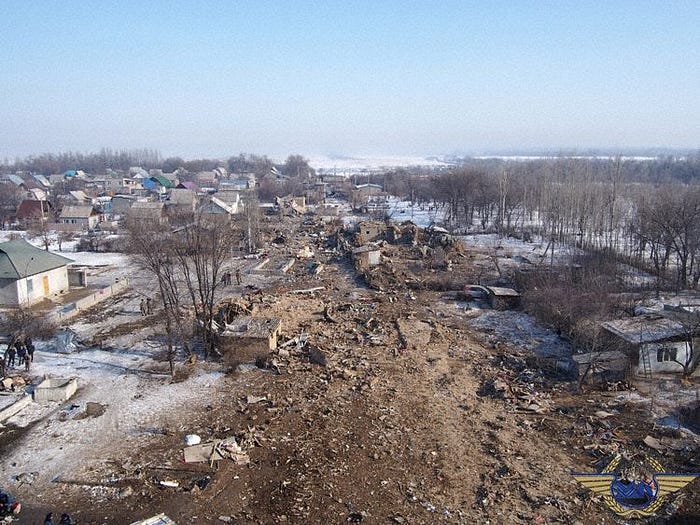
Responsibility for investigating the crash fell to the Interstate Aviation Committee (MAK), the international body which oversees aviation safety across most of the former Soviet Union. The case before them was highly unusual: somehow, a Boeing 747 had landed 900 meters past the end of the runway, in contrast with the vast majority of landing accidents, which typically occur just short of or at the airport. Overshooting the airport in this manner is extremely rare. So how did it happen in Bishkek?
To find out, the MAK recovered the aircraft’s two black boxes and read them out at a facility in Moscow. From the flight data, it was apparent that the plane had been flying too high ever since it left 18,000 feet, primarily due to the captain’s failure to use the speed brakes during a period when a steeper-than-normal descent was required. Following this, the plane intercepted a false glide slope, which caused the autopilot to send the plane along a three degree descent path straight into the village.
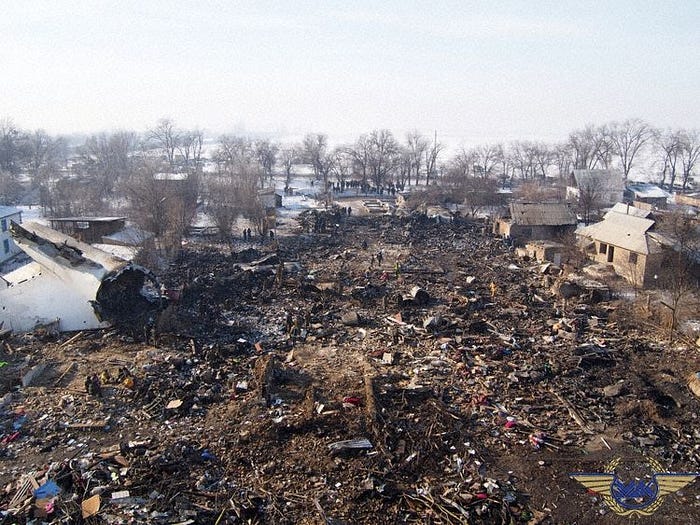
The cockpit voice recorder explained how such a thing could happen. On the first playback, Captain Dirancı’s extremely strong language must have raised some eyebrows. Even more critically, the recording contained clear evidence that the pilots knew they were too high throughout the approach, and in fact this was the source of Dirancı’s agitation. However, despite being aware that they were coming in high, the crew never considered performing an orbit or a go-around. Instead, they pressed onward, making a staggering number of errors in the process. They ignored required position callouts, numerous autopilot and glide slope alerts, and even an EGPWS warning. They failed to perform the landing checklist, missed crucial instrument indications, and descended below the decision height. Without these errors, the crash never would have happened. But the MAK was intrigued to discover that throughout the cruise phase, the pilots faultlessly adhered to the standard operating procedures. The first mistake made by either pilot was the failure to deploy the speed brakes, which rapidly metastasized into an error chain of staggering proportions. The question was why a crew who had been performing perfectly suddenly went off the rails.

The first ingredient was almost certainly fatigue. By the time flight 6491 neared Bishkek, the pilots had been on duty for 11 hours and awake for even longer. The entire flight was conducted in darkness, much of it in the early hours of the morning when the pilots would normally be asleep. Fatigue could have resulted in impaired decision-making, difficulty multitasking, and decreased levels of focus. And most importantly, if the pilots were tired, they might have felt a strong desire to get on the ground and take their scheduled rest break. Colloquially known as “get-there-itis,” this overwhelming urge to get the flight over with has caused pilots to make risky decisions since the very dawn of aviation. It was clear from their words and actions that the pilots became narrowly focused on landing and never seriously considered any other short-term outcome.

The second ingredient was stress. Throughout the approach, Captain Dirancı became increasingly upset over their excessive height, and he vented his frustration by cursing the air traffic controller. The level of stress continued to increase as the approach progressed, combining with the heavy workload of a nighttime approach in bad weather to create a situation in which the pilots experienced task saturation. As tasks piled on, the pilots were unable to focus on all of them at once, and they subconsciously began to push some to the sidelines while directing their attention toward others. These involuntary decisions about which tasks to prioritize were informed by their primal desire to land the airplane, crawl into bed, and go to sleep. Therefore, the pilots gave their attention to items which would facilitate the landing while ignoring evidence that a safe landing could not be accomplished. This was a classic example of confirmation bias: the tendency of the human brain to discount information which does not support its desired or expected outcome.
A simple comparison of the items which the pilots acknowledged versus those they ignored during the final approach into Bishkek clearly illustrates this effect. They discussed their search for the runway, the capture of the localizer and glide slope, and the functioning of the autoland system; simultaneously, they failed to acknowledge various alerts, failed to call out their altitude at various distances from the airport, failed to note passing the final approach fix and the outer marker, and ignored a glide slope warning. Had they focused any attention on these items, it would have been obvious that their approach was hopelessly unsalvageable.

While the MAK identified the actions of the pilots as the main cause of the accident, it did take time to note that the design of the Boeing 747’s autoland system may have exacerbated the situation. Even after losing track of the false glide slope, the autopilot continued to steer the plane along a 3-degree descent trajectory, and the autoland continued to function; in fact, a split second before Dirancı began the go-around at a height of 58 feet, the autoland had started to flare the airplane for landing, unaware that they were not aligned with the runway. The fact that the autoland system was apparently capable of landing the aircraft off the airfield was, in the opinion of the MAK, rather unsafe. It noted that on Russian aircraft with similar capabilities, the autoland system will be automatically disabled if the glide slope signal becomes invalid. The 747 system, in contrast, continued to suggest to the crew that the plane was lined up to land, contradicting other indications which suggested that it was not. This was critical to the errors made by the crew of flight 6491, because it offered evidence that supported their desired outcome and fueled their confirmation bias. However, when the MAK informed the US Federal Aviation Administration about this, the FAA insisted that the Boeing 747 autoland system met all of its requirements.

As a result of the accident, the MAK issued several safety recommendations intended to solve some of the problems uncovered during the investigation. These included that ACT and other airlines provide more training in certain crew resource management areas; that airlines train Boeing 747 crews on the behavior of the autoland system after loss of the glide slope signal; that Boeing redesign the 747 autoland system so that it cannot put the plane down off the runway, and that it provide a warning if a false glide slope is captured; that airports within the MAK’s jurisdiction conduct a review of construction near airports to ensure the safety of residents; and that Boeing resolve a discrepancy between the flight operations manual, which stated that the loss of a glide slope signal does not require crew action if the plane remains on course, and the training manual, which stated that the loss of a glide signal must result in a go-around. By the time of the publication of the MAK’s final report in February 2020, the agency was pleased to note that ACT Airlines had beefed up its crew resource management training and had introduced a simulator training scenario based on the crash.
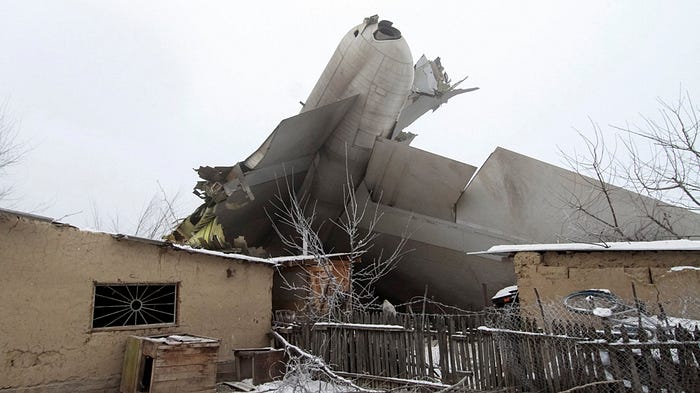
The crash of flight 6491 illustrates the extraordinary power of the psychological traps that every airline pilot must work to avoid. By all indications, both crewmembers were competent pilots; they worked together efficiently and adhered to standard procedures right up until they didn’t. The sheer number of alerts, alarms, and check points that these pilots ignored seems incomprehensible at first glance, but this should stand as a warning about the potency of confirmation bias. In the space of just a few minutes, a combination of confirmation bias, fatigue, and task saturation caused an entirely average flight crew to lose control of their plane — not physically, but mentally. Retaining mental control of the aircraft is just as important as maintaining physical control. While recovery from a physical upset requires timely flight control inputs, recovery from a loss of mental control requires proper situational awareness and a recognition that such a loss of control has occurred. This crucial moment of recognition is all that is needed; thereafter, all a pilot needs to do is hit the proverbial reset button by executing a go-around. Unfortunately, on flight 6491 that critical realization never occurred — a tragic lapse that ultimately cost 39 lives.
_________________________________________________________________
Join the discussion of this article on Reddit!
Visit r/admiralcloudberg to read over 150 similar articles.
You can also support me on Patreon.
